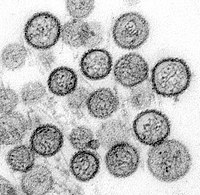
Photo from wikipedia
Previous clinical studies have reported abdominal findings on ultrasonography or MRI in Puumala hantavirus-infected patients. To determine if abdominal computed tomography (CT) can lead to a diagnosis of Puumala virus… Click to show full abstract
Previous clinical studies have reported abdominal findings on ultrasonography or MRI in Puumala hantavirus-infected patients. To determine if abdominal computed tomography (CT) can lead to a diagnosis of Puumala virus infection in the presence of a suggestive clinical picture. CT findings were studied retrospectively in 30 patients who presented to the emergency department of two (Belgian) hospitals with serologically confirmed Puumala hantavirus infection. The most frequent finding was perirenal fascial thickening (90%), followed by perirenal fat stranding (87%). Retroperitoneal fat stranding was found in 19 patients (64%) in the perivesical spaces along the fascia of the external iliac vessels with or without involvement of the presacral fat. Half of the patients had pelvic ascites, and pleural fluid was found in 7 of them. The right and left mean pole-to-pole kidney’s lengths were respectively 125.7 mm and 127.8 mm in 28 patients. Retroperitoneal fat stranding, perirenal fascial thickening and/or perirenal fat stranding were found in most patients with acute Puumala virus infection who have undergone CT. Although nonspecific, these findings may help to suggest Puumala hantavirus infection in the right clinical settings.
Journal Title: Abdominal Radiology
Year Published: 2022
Link to full text (if available)
Share on Social Media: Sign Up to like & get
recommendations!